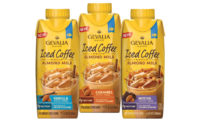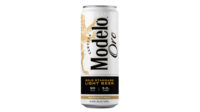As consumers search for that healthy, quenching beverage, non-dairy drinks seem poised to fulfill that need state, experts note. “As more Americans become health conscious, that drives their purchasing decisions with regards to dairy and dairy alternatives,” says Jeffrey Cohen, industry analyst with IBISWorld, Santa Monica, Calif.
| Jump to: |
Cohen notes that fluid milk has experienced slight declines because of consumer concerns about excess fat, growth hormones and antibiotics. At the same time, plant-based alternatives have experienced notable increases, he says.
“Soy and almond milks have lower calorie counts than traditional milk [and] have basically been embraced as a healthier alternative over the past five years, and that’s the major reason we’ve seen sales increase,” he says.
Virginia Lee, senior research analyst for Chicago-based Euromonitor International, estimates that non-dairy milk alternatives increased 13 percent in terms of value from 2011 to 2012. Among these dairy alternatives tracked were soy, almond and coconut. During that same time period, the market research firm estimates that the cow’s milk category decreased 2 percent, she adds.
Euromonitor also is anticipating strong growth in the future for the segment, Lee says. “We’re estimating 47 percent value growth between 2013 and 2018 in the non-dairy milk alternatives [segment],” she says.
IBISWorld also is forecasting healthy sales for dairy alternatives as per capita fluid milk consumption declines, Cohen says. “We are looking at specifically during the five years to 2018 [and] … in the soy and almond milk production industry, we anticipate that revenue will increase at an annualized rate of 5 percent during the five years to 2018 to total about $2 billion for the industry," he says. "We feel, as consumers continue to embrace health consciousness, demand for these drinks will increase.”
Cohen adds that dairy milk is an established, ingrained category in the United States, whereas dairy alternatives started to emerge in the last 10-15 years and now are being embraced by consumers.
“These products are still kind of going through their growth phase, and because of just the fact that they provide healthier alternatives to traditional milk, such as being enhanced [with] vitamin content and lower calorie counts, they’ve been growing much more rapidly,” he says.
Sprouting sales
Highlighted by both Euromonitor’s Lee and IBISWorld’s Cohen, almond milk continues to gain traction in the non-dairy drinks market.
“Almond milk has been experiencing the most explosive sales growth,” Cohen says.
Euromonitor estimates that 2012 value sales increased 50 percent for almond milk in comparison with 2011, Lee notes.
The dairy alternative segment leaders — Denver-based WhiteWave Foods and Sacramento, Calif.-based Blue Diamond Growers — also have noted the growth of this sub-segment in their earnings reports.
WhiteWave stated that net sales for its North American plant-based food and beverages platform, which includes its Silk soy milk, almond milk and coconut milk products, increased 12 percent in the second quarter of 2013 compared with the same time period in 2012. Those sales were highlighted by the strong growth of Silk almond milk, which increased
50 percent in the second quarter, it stated. Almond milk also now accounts for a majority of the plant-based food and beverages unit with an estimated 55 percent share, the company reported.
Information Resources Inc. (IRI), Chicago, estimates that WhiteWave accounted for nearly 57 percent of the refrigerated kefir/milk substitutes/soy milk category for the 52 weeks ending Sept. 8 in U.S. supermarkets, drug stores, mass merchandisers, gas and convenience stores, military commissaries, and select club and dollar retail chains. Its Silk Pure Almond ranked No. 1 in sales for the category with nearly $283 million in sales, which is approximately a 46 percent increase compared with the prior-year period.
Offering a lighter variety, one of the Silk brand's latest releases is Silk Pure Almond Light in Original and Vanilla flavors. Light Original contains 40 calories in each serving, which is one-third fewer calories than Pure Almond Original’s 60 calories, the company says. Light Vanilla also has one-third fewer calories with 60 calories compared with the 90 calories in Pure Almond Vanilla.
A reduction in calorie consumption is among the trends impacting the dairy alternatives category, Euromonitor’s Lee notes.
“With almond milk, packages for the unsweetened variety are touting 30 calories per serving, while the original flavor ranges from 60 to 80 [calories], and that’s lower than both soy milk and cow’s milk,” she says.
“With almond milk, packages for the unsweetened variety are touting 30 calories per serving, while the original flavor ranges from 60 to 80 [calories], and that’s lower than both soy milk and cow’s milk." |
Blue Diamond Growers, a cooperative owned by more than half of the state’s almond growers, announced in its 2012 annual report that it exceeded $1 billion in sales for its snack food and beverage business. For that time period, the company reported that its Almond Breeze aseptic packaged almond milk increased 21 percent, while its refrigerated Almond Breeze almond milk was up 59 percent.
Blue Diamond Growers made up approximately 20 percent of the refrigerated kefir/milk substitutes/soy milk category for the 52 weeks ending Sept. 8 in measured channels, and its Almond Breeze brand ranked No. 3 in sales with more than $217 million, a nearly 53 percent increase, according to IRI data.
Recognizing the growing popularity of almond milk, Blue Diamond Growers is expanding its headquarters to include a 6,500-square-foot almond innovation center.
“The new facility will be a showcase for initiating new almond product concepts for our consumer business and for the most innovative global food companies,” said Mark Jansen, president and chief executive officer of Blue Diamond Growers, in a statement.
The cooperative expects to increase its new almond product sales growth five-fold during the next five years, it said.
Alternative options
Although almond milk is showing the strongest growth, segments like soy milk still make up a strong portion of the overall category’s sales.
“We have soy milk being the most consumed; we have almond milk, which is rapidly catching up, being second; and we have coconut milk being third, which is slightly increasing in demand,” IBISWorld’s Cohen says.
Soy milk still is the most consumed dairy alternative; however, it has been slightly decreasing in favor of almond milk during the last five years based on IBISWorld’s report, he adds.
Euromonitor’s Lee affirms that soy milk has continued to decline. The market research firm estimates that sales for the segment were down
4 percent in 2012.
Despite the segment’s declining sales, soy milk has found favor among consumers. “Consumer opinion seems to be very positive as of now [for dairy alternatives],” Cohen says. “Soy milk, which has only recently over the past couple of years slowed down in sales, has been largely embraced. While this wasn’t the case when it was first introduced, definitely over the past … 10 years it has been increasing in popularity among consumers.”
IBISWorld also has identified coconut milk and rice milk as being on the rise, but Cohen notes that coconut milk producers have faced some challenges when it comes to its growth potential.
For example, the flavor of coconut milk is not as universally appealing as that of almond milk, at least in the United States, Cohen says. “Also, coconut producers over the past five years have faced rising costs, and basically what that has caused them to do is raise the price of coconut milk to consumers, and that has slightly affected demand negatively.”
However, kefir sales have continued to show growth. Lee notes that the sub-segment’s value sales increased 10 percent for 2012.
Sales of Lifeway Foods Inc.’s Lifeway Kefir increased 29 percent to more than $51 million in sales for the 52 weeks ending Sept. 8 in IRI-measured channels.
At Natural Products Expo West in March, the Morton Grove, Ill.-based company unveiled its 14th flavor in its Lifeway Kefir portfolio: Honey Fig. Available in 32-ounce bottles, the cultured milk smoothie was created during Chicago Ideas Week in October 2012, where participants were able to visit Lifeway’s innovation lab and mix and match 45 different flavors, the company says. The company also unveiled Lifeway ProBugs Organic Green Kefir and Lifeway ProBugs Blast. Designed to appeal to kids, ProBugs Organic Green Kefir is a yogurt-like smoothie that contains kale, broccoli, spinach, cabbage and apple. Targeting “tweens,” ProBugs Blast is a new line extension packaged in 3.5-ounce easy-grip containers. The company’s Helios Organic Kefir also underwent some changes in 2013 as the company reformulated and rebranded the product as Helios Greek Kefir. The reformulation included increasing the protein content from 12 grams to 16 grams for each 1-cup serving and infusing honey into all flavors except Original and Vanilla. A new Pear & Honey variety also was released.
“With the changes to our Helios family of kefir products, we now have two distinctly different kefir collections for different palates,” said Julie Smolyansky, president and chief executive officer of Lifeway Foods, in a statement. “Helios Greek Kefir will appeal to consumers looking for a non-fat kefir with extra protein and a sweeter, richer flavor profile. Lifeway Kefir will be the choice for those who prefer the original kefir tart-and-tangy taste. This is an important shift in our product portfolio that not only distinguishes the two brands but also gives the market a clear choice.”
A growing consumer base for dairy alternatives
As dairy alternatives continue to garner consumer support, experts note that manufacturers could take advantage of some opportunities to increase that base.
In Chicago-based Mintel’s “Dairy and Non-Dairy Milk – US” report from April 2013, the market research firm highlights product placement and education as key areas of focus for non-dairy milk producers.
“Non-dairy milk manufacturers should continue to pursue placement in or near the refrigerated case,” the report states. “To some, non-refrigerated brands are not as good; 24 percent of respondents say that non-dairy products that are not sold in the refrigerated section are of lower quality than refrigerated dairy products.”
The report also notes that 44 percent of respondents said that it is easy to forget about non-dairy milk products when they are not near the refrigerated products.
“Education and awareness also could be a focus in order to explain to consumers that shelf-stable dairy and non-dairy products are safe and of the same quality as refrigerated options,” Mintel’s report adds.








